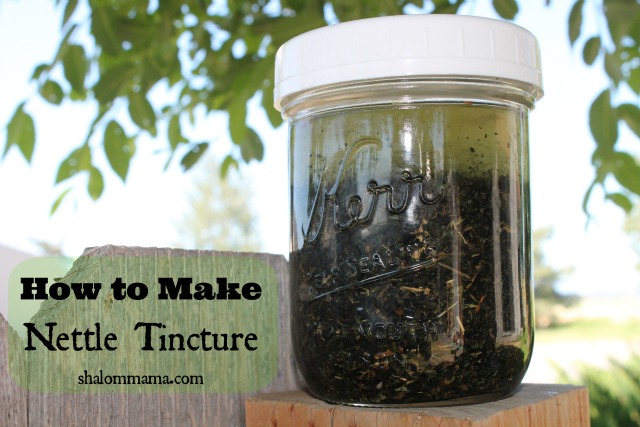One of my favorite herbs is nettle, a plant that I first learned about from my midwife when I was pregnant with Ella (we don’t have stinging nettle where I live, though it turns out my in-laws have it everywhere – I guess I never paid attention!).
Nettle is a nutrient-dense herb, rich in easily-assimilated vitamins A, C, D and K, as well as calcium, potassium, phosphorous, iron and sulfur.
It is well known as a uterine tonic and also strengthens kidneys and adrenals (thank you abundance of vitamins and minerals). Nettle is said to have the highest chlorophyll content of any plant, making it an excellent food.
The calcium content makes it an excellent herb to take for easing leg cramps and muscle spasms. I know I’m not the only one who got those insane Charlie Horse cramps when I was pregnant. I still can’t stretch my legs with my toes pointed for fear of getting another one. Ouch.
Nettle’s calcium content also affects the uterus, helping to diminish pain during and after birth.
Nettle is also a good home remedy for hemorrhoids – its astringency will help tighten and strengthen blood vessels and reduce this problem.
This wondrous herb is also helpful in battling seasonal allergies, which is thought to be caused by nettle’s anti-inflammatory properties and adrenal-supporting nutrients. We’ve used nettle tincture with success for hayfever.
Nettle tincture is most helpful for allergies when taken for more than 30 days, however, we’ve upped the dose for acute allergy symptoms and got pretty quick relief.
You can take nettle a few ways – herbal tea, tincture, or you could even eat the nettle leaves. However, one of the easiest ways to take nettle is via tincture.
A tincture contains concentrated plant properties, usually in alcohol. Sometimes tinctures are made with glycerin, which tastes better but doesn’t keep as long as alcohol-based tinctures (which are said to keep their potency for 2 years or more).
How to Make Nettle Tincture
Ingredients needed:
- 1 pint 90 proof alcohol, like vodka or gin
- 4 oz cut nettle leaf (or thereabouts – you want enough to fill your pint jar half way)
- Pint-size canning jar with lid
- Wooden spoon
- Fine mesh strainer or cheesecloth
- Bowl to strain into (I use this one – it holds my strainer well and can be used for lots of stuff)
- Dark bottle to store tincture (I like the ones with droppers)
Directions
Put the nettle leaf and alcohol in your jar, stir and cover with the lid. Label the jar with what’s inside (very important!).
Place the jar in a cool, dark place, for 2-3 weeks and shake it daily.
When you strain, pour over the strainer into the bowl. Use your wooden spoon to press down on the herbs left in the strainer to get the liquid out. Pour the finished tincture in your dark bottle to store and seal the lid tightly.
Use
Since I store my tincture in bottles with droppers, I use 1-3 dropperfuls when I need to take this. For allergies, I do 2 dropperfuls daily to prevent symptoms. I put the tincture in about 4 ounces of water, then hold it in my mouth for a few seconds before swallowing.
Some take the tincture sublingually (under the tongue), which gets it into your bloodstream quicker. However, the strong taste keeps many people from doing this.



I have known for years that nettles is very beneficial so thank you for this article. My question is this: Does the alcohol neutralize the stinging properties of the nettles? I assumed it needed to be cooked first?
je prends l’ortie en JUS CRU filtré
préparé avec un extracteur de jus , j’ajoute de la bonne eau régénérée (système plocher )
filtré avec tissu intissé
bises
I’d like to try this. Do you use fresh nettle, or can you use dried?
I use dried.
Thank you for sharing. I was looking to see if I could take it during pregnancy. Excited to see I can. I never heard of diluting the tincture in water, but why not if you can use it in a tea. Thanks for the tip.
Last year, I made my own tincture for allergies from fresh leaves. It is FAR BETTER than any other medication I have ever taken. When I am at the point of wanting to rip my eyes out I feel totally better within 10-15 minutes (I put it straight under my tongue). It is best when you take it on a regular basis to prevent issues. It doesn’t last as long (about 4 hours), so if I’m going to be out a lot I am sure to take some with me. Oh, I LOVE IT!
To answer the first reply, if you are making a nettle, no, you do not need to cook it. I would wear kitchen gloves when making it and then wash anything you used.
what about doing this a glycerine?
Thank you for sharing your knowledge… I’m so happy I found your site!
He who is generous will be blessed, For he gives some of his food to the poor… Proverbs 22:9
I have lots of nettles available, how would I make a tincture with fresh nettles? I’m also interested in using the juice or making a fresh infusion, but I’m uncertain about safe dosages. Does anyone have any information on this? Thanks!
I am amazed at all the wonder uses Stinging Nettles is used for. I use the live Nettles to sting my arthritic joints in my dominant hand. It has made it so I don’t have to utilize doctor prescribed pain pills as often. I have made this day, my first attempt at a Tincture of Stinging Nettles. I hope that this will be what takes me through the winter months when I can’t get and live Nettles to apply to my arthritis. Here’s hoping!!!
Nettle is an excellent diuretic, much safer than commercial products.
Great post! Can I used nettle root powder instead of the root?
Hi Andrew. You can, you’ll just need to strain it more carefully when it’s done.
My friend recently put me onto this, as she makes her herself, however she told me to make it only with the nettle seeds, not the leaves.
hello! I am curious what be the difference would be between using the root or the leaves?
thank you!
Can I rip open organic nettle tea bags and use that to make my tincture?
Hello, i make nettle tea from dried leaves for my allergies and am going to try the tincture. I have jars full of dried leaves from 2 yrs ago will these be ok to use in the recipe or do i need fresh? Thanks
Hi Mike. I talked to my dad who’s been an herb farmer for the last 25 years. He said that should be fine as long as they were kept in a cool, dry place out of the sun.
I’ve been using Nettle Leaf for over two years now. I have been able to reduce my use of prescription antihistamine to a fraction of what it was.
That’s awesome!
Hi – how much would you say is in a dropperful?
Mine are usually 15 ml.
I use Stinging Nettle to make an allergy tincture with equal parts of Horseradish root. I have made it for years. Can’t afford to buy the Nettle and Radish allergy tincture I have used since 2004.
I actually prefer to make my own. I prefer stronger horseradish in my allergy tincture.
Great Post. Thank you for sharing.
1. Shall I need to wash the nettle before use I mean before drying?
Do washing the nettle flesh out it benefits?
2. Can I take both roots and leaves for making tincture?
Thanks for this recipe. Going to make a tincture for leg pain, histamine intolerance etc. Hope it helps! I’ll come back in a month and let you know.
I just made this tincture. So easy when you have access to fresh nettles. I followed the recipe and it made about 14 small brown bottles with stoppers. Can’t wait to begin my daily regimen!
Is it only the leaves or can you use the flowers too?